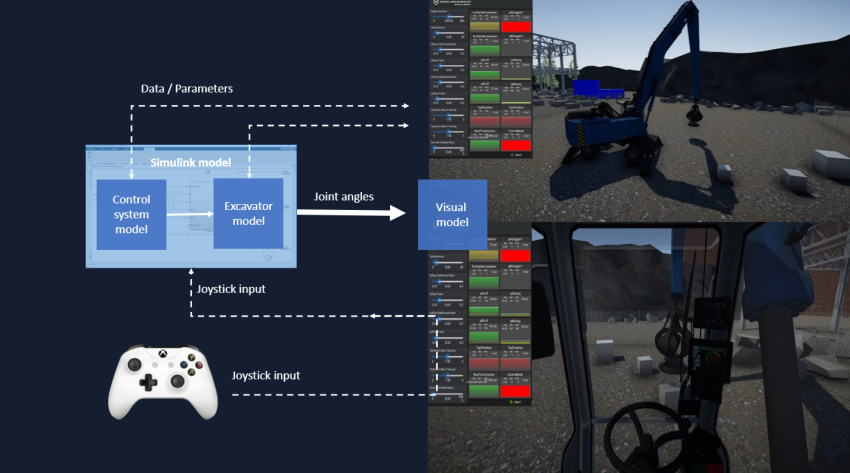10/02/2021
Why Digital Prototype?
Elomatic and Devecto have developed a method to combine the 3D world and the physics model of a machine together into a realistic digital prototype. In this article, our guest writer Karl-Kristian Högstrom will talk about the method, the technology behind it, and the benefits it offers in R&D.
Minimizing the time spent iterating between development and testing is crucial. Especially when developing complex machinery, where prototype building is a tedious process that requires lots of time. Use of agile methodologies and fail-fast principles in R&D help, but further improvements are needed. Use of digital prototypes can be this next step.
For a digital prototype to be useful, we need to be able to examine it from different points of view – we need both “the look” and “the feel”. 3D models and virtual landscapes offer “the look”. We can evaluate how our machine looks on the inside and outside, and to some extent the usability. The evaluation of performance is not possible with a 3D model alone. However, “The feel” can be obtained by modelling the dynamics of the machine mathematically. By connecting the dynamics model to the 3D model, we can have both the look and the feel in a realistic digital prototype that can be used for testing and evaluation prior to building the physical prototype.
The joint power of Unity and Simulink
There are many proprietary simulation systems available, and there has certainly been a need for simulation systems that are easy to use for a specific purpose. Typical example is a training simulator. However, the development possibilities with a proprietary system are always limited and/or require special knowledge.
Elomatic and Devecto have developed a method called The Link to combine the 3D world and the physics model of the device/machine together into a realistic simulation with commonly used and widely available tools. The 3D world with a realistic landscape is running in Unity. The physical properties of the machine are modeled in Simulink. These two models are connected so that information flows both ways. Unity and Simulink as development tools are improving all the time and the development of a simulation system with them is already very efficient. The system is not limited in any way to a specific purpose, and simulation can be used as a tool in various phases of the product development.

The example presented here is an imaginary Terex Fuchs material handling machine. The control system, hydraulics and mechanics of the machine is modeled in Simulink. The machine in virtual landscape is operating in Unity. There is a dashboard that shows values from the machine model such as hydraulic pressures in cylinders. In the dashboard there is a possibility to adjust parameters in the Simulink model. Collisions and other interactions with the virtual environment can flow from Unity to the Simulink model.
Learn more about digital prototypes!
Homepages: The Link – Digital Prototype
Upcoming event
Simulink Forum, 12.2.2021 at 9.30-12.30 EET.
Theme: “Using simulation and digital prototypes in different stages of product and development”
Agenda:
- What is digital prototype? + demo, Harri Laukkanen, Devecto & Jani Moisala, Elomatic
- Simulation as a part of testing and quality assurance, Antero Salojärvi, Avant Tecno
- The benefits and the challenges of modelling, Aleksi Vesala, Valtra
- Utilizing models in various stages of product and development, TBD Mathworks

